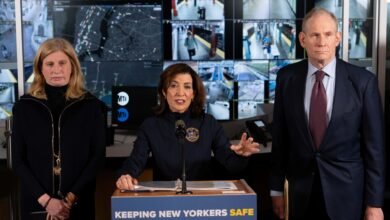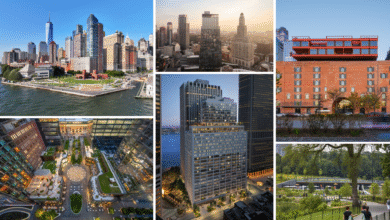Elevated by 10 feet, Battery Park City’s Wagner Park reopens with new flood protection


All images courtesy of Battery Park City
Wagner Park in Battery Park City reopened on Tuesday after a two-year overhaul to better protect the park and Lower Manhattan from coastal flooding. As part of the Battery Coastal Resilience Project, much of the 3.5-acre park was elevated by 10 feet to hide a buried floodwall under the central lawn that will protect against storm surge. There’s a 63,000-gallon underground cistern for rainwater reuse and lush gardens planted with native, salt-resistant species. The park’s flood risk reduction system includes both passive and deployable measures, designed to withstand a 100-year storm and projected to protect from severe storms through the 2050s based on anticipated sea level rise.

“The Battery Park City Authority is thrilled to deliver Wagner Park back to the public with this environmentally sustainable, downtown destination featuring expansive lawns and gardens, programming spaces, beautiful views, and universal accessibility,” BPCA Chairman Don Capoccia said.
“Let this magnificent public space overlooking the Statue of Liberty and Ellis Island serve as testament to the resilient spirit of New York.”
Designed by AECOM in partnership with the Battery Park City Authority, Wagner Park now features an integrated flood barrier system seamlessly built into the landscape to guard against future storm surges and sea level rise.
The park also has an upgraded stormwater management system that uses grading and directs water into a system that maximizes rainwater capture and reuse.

Sustainable materials such as salvaged stone, wood, and trench drains from the original park were reused in the reconstruction. New paving materials were chosen to reduce heat island effects, and energy-efficient, solar-powered lighting enhances nighttime visibility while minimizing glare.
The park now includes four planted regional ecosystems: a tidal estuary, maritime meadow, maritime forest, and upland woodland. These native landscapes reduce water use, require less maintenance, and support local biodiversity.
An upgraded subsurface irrigation system cuts turfgrass water consumption by more than 30 percent. Additionally, a new area at the Pier A inlet encourages marine growth and offers space for environmental education and marine awareness.

Designed by Thomas Phifer and Partners, the new Pavilion is accessible from Battery Place via two sloped gardens, or from the waterside esplanade using accessible ramps and stairs, offering multiple entry points for visitors. Arched vaults lead to an entry piazza, where sweeping views of the green space, harbor, the Statue of Liberty, and Ellis Island take form.
The Pavilion will open in phases, with a classroom scheduled to debut this fall and a new restaurant expected in 2026. The new dining replaces the Italian restaurant Gigino at Wagner Park, which has operated there since 1999.
Pursuing Living Future Institute’s Zero Carbon Certification, the Pavilion is fully electric and free of any on-site combustion. The building will also include public restrooms and a spacious rooftop terrace open to the public, offering sweeping views of the harbor.
The new park has achieved Waterfront Edge Design Guidelines verification from the Waterfront Alliance—the gold standard for resilient, ecological, and accessible waterfront design.
Wagner Park will continue to host public art and free community programming. Alongside temporary installations, the park will serve as the permanent home for three major sculptures: “Resonating Bodies” by Tony Cragg, “Eyes” by Louise Bourgeois, and the “Mother Cabrini Memorial” by Jill Burkee and Giancarlo Biagi.

Wagner Park closed in March 2023 for construction. In April 2024, the BPCA issued a request for proposals (RFP) for the planned restaurant within the Pavilion.
The Battery Coastal Resilience project is one component of the larger $1.7 billion Lower Manhattan Coastal Resiliency (LMCR) initiative, which aims to protect Lower Manhattan from future flooding and sea level rise. The larger plan includes raising waterfront infrastructure and enhancing the area’s rainwater management systems.
In May 2024, city officials broke ground on the $200 million Battery Coastal project. Scheduled for completion in 2026, the project aims to protect 100,000 residents, 300,000 jobs, and 12,000 businesses in the area.
Other components of the Lower Manhattan Coastal Resiliency (LMCR) initiative include the Brooklyn Bridge-Montgomery Coastal Resilience project, which began construction in fall 2022, and the $1.45 billion East Side Coastal Resiliency project, with its first two public areas opened in 2022 and 2023.
Later this year, work will begin on the North/West Battery Park City Resiliency Project, an interconnected network of fixed flood barriers and deployable measures designed to protect the remaining areas of Battery Park City and western Tribeca from flooding.
“More than a decade after Superstorm Sandy, our climate adaptation work continues with the return of a beautiful new Wagner Park,” BPCA President & CEO Raju Mann said. “Today’s reopening marks another step in our collective efforts to build a more resilient Lower Manhattan. We have a lot of work ahead, but today is a day to celebrate what we can do when we work together.”
RELATED:




